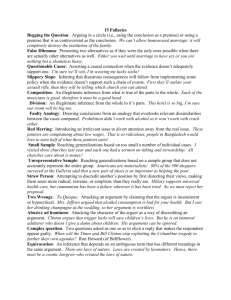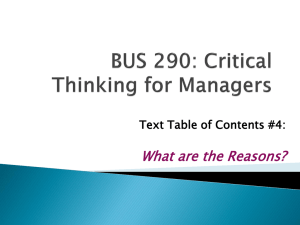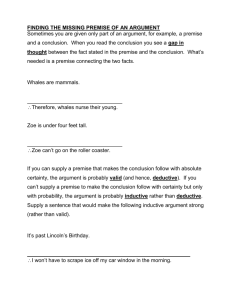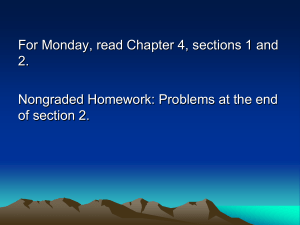Symbolic Logic: Arguments & Inference Rules
advertisement
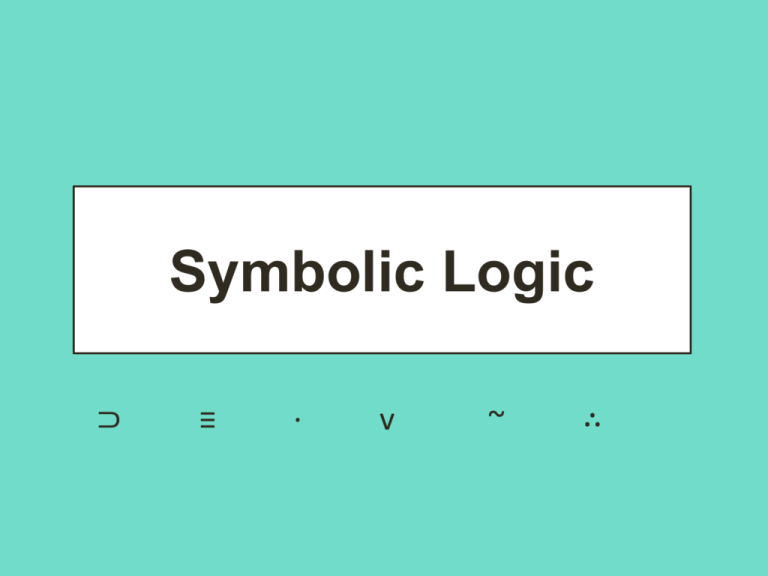
Symbolic Logic ⊃ ≡ · v ~ ∴ What is a logical argument? • Logic is the science of reasoning, proof, thinking, or inference. Logic allows us to analyze a piece of deductive* reasoning and determine whether it is correct or not – to determine if the argument is valid or invalid. • As a debater, logic is your tool to assess arguments – yours and your opponents – with accuracy and precision. What is a logical argument? *A deductive argument is one that, if valid, has a conclusion that is entailed by its premises. Meaning, the truth of the conclusion is a logical consequence of the premises—if the premises are true, then the conclusion must be true. Review: Valid: The conclusion of the argument follows logically from its premises. Sound: The argument is valid and all of its premises are true. Symbolic logic is used to check the validity of an argument, not the truth of its premises (that is what research of evidence for). A logical argument has three stages: Premises: The claims that are given in support of an argument -the building blocks of a logical argument. A premise is a propositional statement which is either true or false. Inference: The logical move from one or more premises to arrive at its conclusion. All inferences must abide by a rule of inference for an argument to be valid. Conclusion: The premise that is the consequence, or product, of the above premises + inference.* *A conclusion can then itself become a premise (building block) of a continued or new argument. What is a logical argument? A logical argument has three stages: 1) If data suggests that students would get more sleep with a later start time, then WHS will change its start time to 9 am (premise 1) 2) Data does suggest that students would get more sleep with a later start time. (premise 2) _____________________ (Inference, M.P.) 3) Therefore, WHS will start at 9 am. (conclusion) What is symbolic logic? Symbolic logic symbolizes arguments for simple, efficient assessment of validity. As arguments get longer and more complex, symbols are especially important. 1) If data indicates that students would get more sleep, then WHS will change its start time to 9 am (premise 1) 2) Data indicates that students would get more sleep (premise 2) _____________________ (Inference, M.P.) 3) Therefore, WHS will start at 9am. (conclusion) For example: 1) If Data indicates that students would get more sleep, then WHS will change its Start time to 9 am (premise 1) 2) Data indicates that students would get more sleep (premise 2) _____________________ (Inference) 3) Therefore, WHS will Start at 9am. (conclusion) Becomes… 1) D ⊃ S 2) D ______________ 3) ∴ S (M.P.) This argument is deemed valid by use of inference rule Modus Ponens (M.P.) Rules of Inference Modus Ponens (M.P.) p⊃q p ∴q Constructive Dilemma (C.D.) (p ⊃ q) · (r ⊃ s) pvr ∴qvs Modus Tollens (M.T.) p⊃q ~q ∴ ~p Destructive Dilemma (D.D.) (p ⊃ q) · (r ⊃ s) ~q v ~s ∴ ~p v ~r Hypothetical Syllogism (H.S.) p⊃q q⊃r ∴p⊃r Simplification (Simp.) p·q ∴p Disjunctive Syllogism (D.S.) pvq ~p ∴q Conjunction (Conj.) p q ∴p·q Addition (Add.) p ∴pvq Symbols Key Name Symbol Reads as: Conditional ⊃ “if ____, then____” Biconditional ≡ “____if and only if ____” Conjunction · “____ and ____” Disjunction v “____ or ____ (but not neither)” Negation ~ “not ____” Conclusion ∴ “Therefore, ____” Modus Ponens (M.P.) 1) s ⊃ c 2) s ______________ 3) ∴ c 1) If you Smoke, then you increase your risk of Cancer. 2) You Smoke. ______________________ 3) Therefore, you increase your risk of Cancer. (M.P.) Modus Ponens (M.P.) 1) c ⊃ f 2) c ______________ 3) ∴ f 1) If one is a Cat, then one has Four legs. 2) I have Four legs. ______________________ 3) Therefore, I am a cat. 1) c ⊃ f 2) f ______________ 3) ∴ c Modus Tollens (M.T.) 1) s ⊃ b 2) ~b ______________ 3) ∴ ~s 1) If it is Snowing, then it is 32 F or Below. 2) It is not 32 F or Below. _____________ 3) Therefore, it is not Snowing. (M.T.) Hypothetical Syllogism (H.S.) c⊃m m⊃s ∴c⊃s 1) If you give a mouse a Cookie, then he will want Milk. 2) If you give a mouse Milk, then he will want a Straw. ______________________ 3) Therefore, If you give a mouse a Cookie, then he will want a Straw. (H.S.) Disjunctive Syllogism (D.S.) pvq ~p ∴q 1) You must have a Salad or Cup of soup. 2) You do not choose to have a Salad. ______________________ 3) Therefore, you must choose to have a Cup of soup. (D.S.) Note: The wedge “v”, used to symbolize “or” means you can have one, the other, or both, but not neither. It is used like “and/or”. Constructive Dilemma (C.D.) (c ⊃ m) · (i ⊃ s) cvi ∴mvs 1) If you give a mouse a Cookie, then he will want Milk, and If you give a mouse Ice cream, then he will want Sprinkles 2) The mouse can have a Cookie or Ice cream. ______________________ 3) Therefore, the mouse must have Milk or Sprinkles. (C.D.) Destructive Dilemma (D.D.) (c ⊃ m) · (i ⊃ s) ~m v ~s ∴ ~c v ~i 1) If you give a mouse a Cookie, then he will want Milk, and If you give a mouse Ice cream, then he will want Sprinkles. 2) The mouse must choose between no Milk or no Sprinkles. ______________________ 3) Therefore, the mouse must choose between no Cookie or no Ice cream. (D.D.) Simplification (Simp.) g·b ∴g 1) WHS has Girl students and Boy students. _____________ 2) Therefore, WHS has Girl students. (Simp.) Conjunction (Conj.) p q ∴p·q 1) WHS has Girl students. 2) WHS has Boy students. _____________ 2) Therefore, WHS has Girl and Boy students. (Conj.) Addition (Add.) g ∴pvq 1) WHS has Girl students. ________________ 2) WHS has Girl students or Boy students. (Add.) Remember: The wedge (v) means you can have one, the other, or both, but not neither -- like “and/or”.

